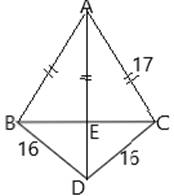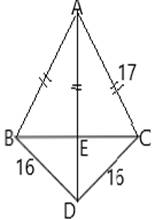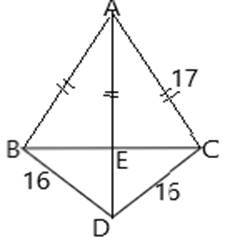
a.
To calculate: The area of each lateral face of a triangular pyramid with dimensions as 16 and 17.
a.
Answer to Problem 2PSA
The area of each lateral face of a triangular pyramid is
Explanation of Solution
Given information:
A triangular pyramid with dimensions as 16 and 17.
Formula used:
The below theorem is used:
Pythagoras theorem states that “In a right angled triangle, the square of the hypotenuse side is equal to the sum of squares of the other two sides”.

In right
Area of triangle:
b = base of triangle
h = height of triangle
Calculation:

Since it is regular, all the lateral faces are equal.
Draw altitude perpendicular to base.
The altitude AE can be calculated by applying Pythagoras Theorem.
In right angle triangle AEC , we get
The altitude AE drawn perpendicular divides the triangle face into two right
Lateral face is triangle.
Area of lateral face
Area of lateral face = 120
b.
To find: The base area of a triangular pyramid with dimensions as 16 and 17.
b.
Answer to Problem 2PSA
The base area of a triangular pyramid is
Explanation of Solution
Given information:
A triangular pyramid with dimensions as 16 and 17.
Formula used:
The below theorem is used:
Pythagoras theorem states that “In a right angled triangle, the square of the hypotenuse side is equal to the sum of squares of the other two sides”.

In right angle triangle,
Area of equilateral triangle:
s = side of equilateral triangle.
Calculation:

Because the figure is a regular
Area of equilateral triangle:
c.
To calculate: The total area of a triangular pyramid with dimensions as 16 and 17.
c.
Answer to Problem 2PSA
The total area of a triangular pyramid is
Explanation of Solution
Given information:
A triangular pyramid with dimensions as 16 and 17.
Formula used:
The below theorem is used:
Pythagoras theorem states that “In a right angled triangle, the square of the hypotenuse side is equal to the sum of squares of the other two sides”.

In right angle triangle,
Area of triangle:
b = base of triangle
h = height of triangle Area of equilateral triangle:
s = side of equilateral triangle.
Total area of pyramid = Area of lateral faces + Area of equilateral triangle
Calculation:

Since it is regular, all the lateral faces are equal.
Draw altitude perpendicular to base.
The altitude AE can be calculated by applying Pythagoras Theorem.
In right angle triangle AEC , we get
The altitude AE drawn perpendicular divides the triangle face into two right triangles of
Lateral face is triangle.
Area of lateral face
Area of lateral face = 120
Because the figure is a regular polygon, the triangle base is also regular, which means it is equilateral.
Area of equilateral triangle:
Total area of pyramid = Area of lateral faces + Area of equilateral triangle
There are three lateral faces.
Total area of pyramid = (3
Total area of pyramid
Total area of pyramid
Chapter 12 Solutions
Geometry For Enjoyment And Challenge
Additional Math Textbook Solutions
Elementary Statistics: Picturing the World (7th Edition)
Algebra and Trigonometry (6th Edition)
College Algebra with Modeling & Visualization (5th Edition)
A Problem Solving Approach To Mathematics For Elementary School Teachers (13th Edition)
Calculus: Early Transcendentals (2nd Edition)
- 18:36 G.C.A.2.ChordsSecantsandTa... จ 76 完成 2 In the accompanying diagram, AABC is inscribed in circle O, AP bisects BAC, PBD is tangent to circle O at B, and mZACB:m/CAB:m/ABC= 4:3:2 D B P F Find: mZABC, mBF, m/BEP, m/P, m/PBC ← 1 Őarrow_forward14:09 2/16 jmap.org 5G 66 In the accompanying diagram of circle O, diameters BD and AE, secants PAB and PDC, and chords BC and AD are drawn; mAD = 40; and mDC = 80. B E Find: mAB, m/BCD, m/BOE, m/P, m/PAD ← G.C.A.2.ChordsSecantsand Tangent s19.pdf (538 KB) + 4 保存... Xarrow_forward16:39 < 文字 15:28 |美图秀秀 保存 59% 5G 46 照片 完成 Bonvicino - Period Name: 6. A right regular hexagonal pyramid with the top removed (as shown in Diagram 1) in such a manner that the top base is parallel to the base of the pyramid resulting in what is shown in Diagram 2. A wedge (from the center) is then removed from this solid as shown in Diagram 3. 30 Diogram 1 Diegrom 2. Diagram 3. If the height of the solid in Diagrams 2 and 3 is the height of the original pyramid, the radius of the base of the pyramid is 10 cm and each lateral edge of the solid in Diagram 3 is 12 cm, find the exact volume of the solid in Diagram 3, measured in cubic meters. Show all work. (T 文字 贴纸 消除笔 涂鸦笔 边框 马赛克 去美容arrow_forward
- Answer question 4 pleasearrow_forward16:39 < 文字 15:28 |美图秀秀 保存 59% 5G 46 照片 完成 Bonvicino - Period Name: 6. A right regular hexagonal pyramid with the top removed (as shown in Diagram 1) in such a manner that the top base is parallel to the base of the pyramid resulting in what is shown in Diagram 2. A wedge (from the center) is then removed from this solid as shown in Diagram 3. 30 Diogram 1 Diegrom 2. Diagram 3. If the height of the solid in Diagrams 2 and 3 is the height of the original pyramid, the radius of the base of the pyramid is 10 cm and each lateral edge of the solid in Diagram 3 is 12 cm, find the exact volume of the solid in Diagram 3, measured in cubic meters. Show all work. (T 文字 贴纸 消除笔 涂鸦笔 边框 马赛克 去美容arrow_forwardAnswer question 3 pleasearrow_forward
- Answer question 3 pleasearrow_forward38 Below triangle is isosceles. Find the value of x. 70° 60° x 20° Warrow_forwardTo approximate the length of a marsh, a surveyor walks x = 400 meters from point A to point B. Then, the surveyor turns 75° and walks 220 meters to point C (see figure). Approximate the length AC of the marsh. (Round your answer to one decimal place.) m C B 75° 220 m x marrow_forward
- . The students who attend Memorial High School have a wide variety of extra-curricular activities to choose from in the after-school program. Students are 38% likely to join the dance team; 18% likely to participate in the school play; 42% likely to join the yearbook club; and 64% likely to join the marching band. Many students choose to participate in multiple activities. Students have equal probabilities of being freshmen, sophomores, juniors, or seniors.What is the probability of the union of being either a freshman or senior? 0.07 0.44 0.50 0.25arrow_forwardWhich angles are complementary to each other? Select all that apply. 3 2 4 in 5 1 Z1 and 23 Z1 and 25 22 and 23 Z2 and 25 Submitarrow_forwardWhich angles are adjacent to each other? Select all that apply. 3 2 4 67 5 8 11 10 12 12 9 27 and 28 Z9 and 12 Z3 and 24 Z10 and Z11arrow_forward
 Elementary Geometry For College Students, 7eGeometryISBN:9781337614085Author:Alexander, Daniel C.; Koeberlein, Geralyn M.Publisher:Cengage,
Elementary Geometry For College Students, 7eGeometryISBN:9781337614085Author:Alexander, Daniel C.; Koeberlein, Geralyn M.Publisher:Cengage, Elementary Geometry for College StudentsGeometryISBN:9781285195698Author:Daniel C. Alexander, Geralyn M. KoeberleinPublisher:Cengage Learning
Elementary Geometry for College StudentsGeometryISBN:9781285195698Author:Daniel C. Alexander, Geralyn M. KoeberleinPublisher:Cengage Learning

